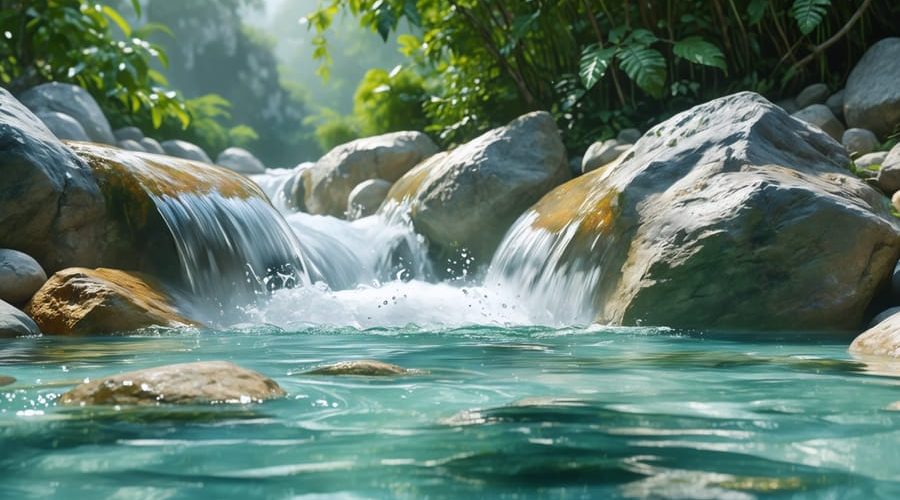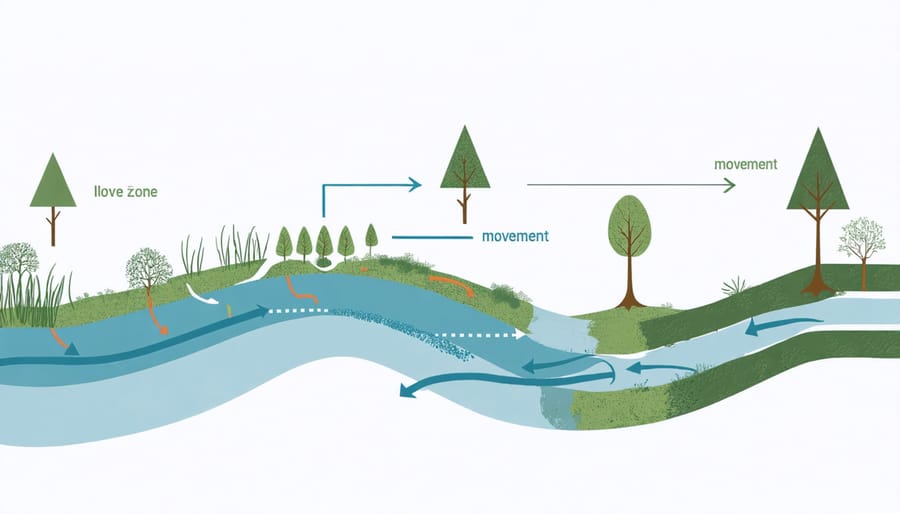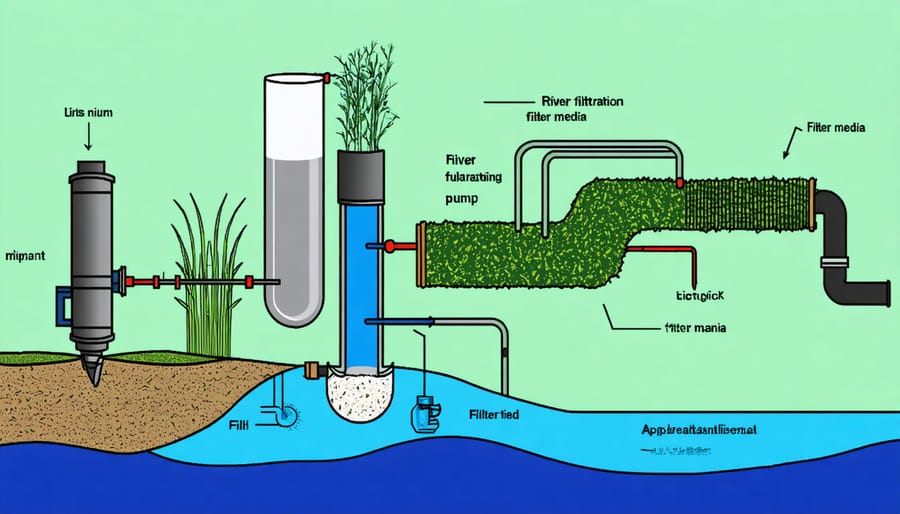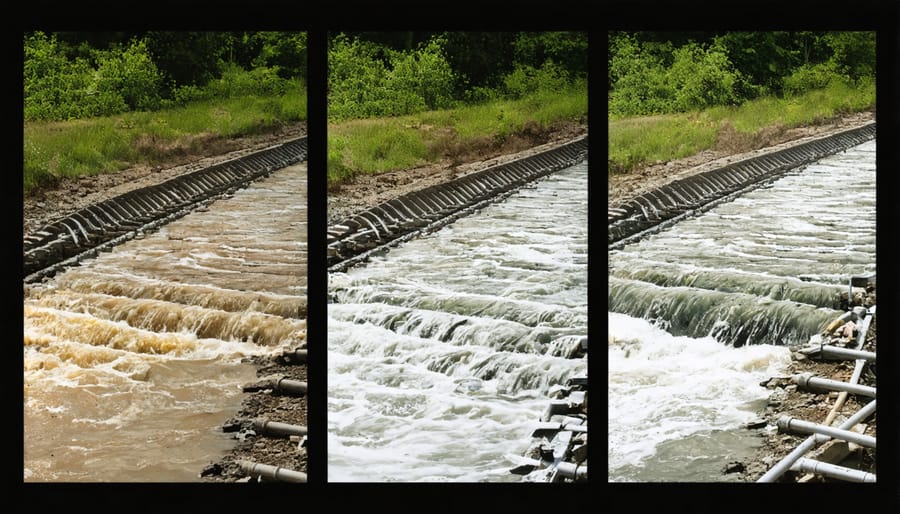
Transform Your Pond’s Water Quality with a DIY River Filtration System
Transform your river’s water quality with a professionally designed filtration system that mimics nature’s own purification process. Natural river filtration combines mechanical, biological, and chemical processes to create crystal-clear water while supporting healthy aquatic ecosystems. Whether you’re managing a small stream or a large river system, proper filtration removes harmful contaminants, maintains optimal oxygen levels, and creates a thriving environment for fish and plant life.
A well-designed river filtration system works round the clock to trap debris, break down organic waste, and balance crucial water parameters. By incorporating elements like gravel beds, beneficial bacteria colonies, and strategic water flow patterns, these systems can effectively handle large water volumes while requiring minimal maintenance. Today’s filtration technology offers solutions that are both environmentally friendly and cost-effective, making clean water accessible for various applications.
Modern river filtration combines time-tested methods with innovative solutions, creating systems that adapt to changing environmental conditions. From simple gravity-fed designs to advanced multi-stage configurations, these systems provide reliable water quality management while preserving the natural balance of river ecosystems.
Why River Filtration Systems Work Better Than Standard Filters
Natural Water Movement Patterns
Nature has perfected water filtration over millions of years, and understanding these processes can help us create better standard pond filtration systems. In rivers, water naturally purifies itself through a fascinating combination of movement patterns and oxygenation processes.
As water flows over rocks and natural barriers, it creates turbulence that introduces oxygen into the water. This oxygen-rich environment supports beneficial bacteria that break down organic waste and harmful compounds. The movement also helps suspend particles in the water, preventing them from settling and creating stagnant areas.
Rivers incorporate natural filtering zones where water slows down, allowing sediment to settle in deeper pools while plants along the banks absorb excess nutrients. These areas work like nature’s own settling tanks! The continuous flow also creates small rapids and cascades, which act as natural aerators, much like the bubblers we use in our ponds.
Understanding these natural patterns helps us design more effective pond systems that mimic nature’s time-tested methods. By incorporating similar features in our ponds, we can work with nature rather than against it.

Biological Filtration Benefits
Biological filtration is nature’s way of keeping water clean, and it’s truly fascinating how it works in river systems. Beneficial bacteria are the unsung heroes of this process, working tirelessly to break down harmful compounds and maintain water quality. These microscopic helpers colonize various surfaces in your filtration system, converting toxic ammonia from fish waste into less harmful nitrates through a process called nitrification.
When you incorporate biological filtration into your pond system, you’re essentially recreating these natural oxygenation processes that occur in rivers. The bacteria form a biofilm on filter media, plant roots, and rocks, creating a living ecosystem that continuously cleans your water. This natural approach not only maintains crystal-clear water but also creates a healthier environment for fish and plants.
The best part? Once established, biological filtration requires minimal maintenance and works 24/7. It’s like having a tiny cleanup crew that never takes a break! Just remember that these beneficial bacteria need time to develop, so patience is key when starting a new system or making significant changes to your existing setup.
Building Your River Filtration System
Essential Components
A successful river water filtration system relies on several key components working together. When it comes to choosing the right filtration components, you’ll need both mechanical and biological elements for optimal results.
Start with a reliable pump that’s appropriately sized for your water volume. Look for an energy-efficient model with adjustable flow rates – this will be the heart of your system. You’ll also need a pre-filter or skimmer to catch larger debris before it enters the main filtration system.
For mechanical filtration, you’ll want filter media like foam mats or filter pads in various densities. These catch particles of different sizes, from large debris to fine sediment. Bio-media comes next – materials like bio-balls, ceramic rings, or lava rock provide surface area for beneficial bacteria to colonize.
A UV clarifier is optional but highly recommended for controlling algae growth. You’ll also need plumbing components including flexible tubing, PVC pipes, valves, and appropriate fittings. Don’t forget about the distribution system – spray bars or fountain heads help aerate the water as it returns to your pond.
For installation and maintenance, keep basic tools handy: pipe cutters, silicon sealant, cleaning brushes, and water testing kits. Remember, quality components might cost more initially but save money long-term through better efficiency and durability.

Installation Steps
Setting up your river water filtration system is a straightforward process when you follow these steps carefully. Let’s break it down into manageable tasks that you can complete over a weekend.
First, choose a suitable location for your pump at the deepest part of your water feature. This spot should be easily accessible for maintenance but not too visible. Place the pump on a flat paver or sturdy platform to keep it stable and slightly elevated from the bottom.
Next, lay out your filtration piping. Start by connecting the intake pipe to your pump, ensuring all fittings are tight and secure. Run the piping along the edge of your water feature, using landscaping rocks or plants to conceal it naturally. If you’re working with multiple filter stages, position them in ascending order of filtration fineness.
For the mechanical filter installation, dig a small pit near the water’s edge where your filter housing will sit. The pit should be level and slightly larger than your filter container. Line the bottom with gravel for drainage, then place your filter housing inside. Layer your filter media starting with the coarsest at the bottom: lava rock first, then bio-balls, and finally your fine filter material.
Now it’s time to set up the biological filtration zone. Create a shallow depression for your bog garden about 6-12 inches deep. Line it with pond liner, leaving extra material at the edges. Fill the bottom with gravel, then add your chosen aquatic plants. This area will serve as your natural filter, removing excess nutrients from the water.
Connect all components using flexible tubing, securing each connection with hose clamps. Double-check that water flows smoothly through the entire system before covering any exposed piping with gravel or decorative stones.
Finally, plug in your pump and observe the water flow. You should see water moving steadily through each filtration stage and returning to your water feature through the biological filter zone. Make any necessary adjustments to flow rates or positioning to optimize performance.
Remember to monitor the system for the first few days to ensure everything is working properly. Keep an eye out for leaks or irregular water flow patterns that might indicate a problem. Within a few weeks, you’ll notice clearer water and healthier plant growth as your filtration system establishes itself.
Common Setup Mistakes to Avoid
When setting up your river water filtration system, avoid these common mistakes that can compromise its effectiveness. First, don’t undersize your pump – it’s better to go slightly larger than risk insufficient water flow. Many beginners make the mistake of placing their intake too close to the surface, missing the debris that settles at lower levels.
Another frequent error is incorrectly layering filtration media. Always arrange materials from coarse to fine, allowing larger debris to be caught first. Skipping the pre-filter is a costly mistake that can lead to clogged main filters and reduced efficiency.
Watch out for bypass issues – water should flow through, not around, your filter media. Ensure all connections are properly sealed and media is packed correctly. Don’t forget to leave enough space between media layers for beneficial bacteria to thrive.
Positioning matters too – never place your filter system in direct sunlight or areas prone to flooding. Some DIY enthusiasts make the mistake of burying their pipes too shallow, risking freeze damage in winter.
Finally, avoid the temptation to clean your filter too frequently. Over-cleaning can disrupt the beneficial bacterial colonies that are essential for biological filtration. Instead, wait until you notice reduced flow rates before performing maintenance.
Maintaining Your River Filtration System

Seasonal Maintenance Tasks
Maintaining your river water filtration system requires different attention throughout the year to ensure optimal performance. In spring, as temperatures rise, start by removing any debris that accumulated during winter. Clear out fallen leaves and twigs from the pre-filter, and gently clean biological filter media with pond water to preserve beneficial bacteria.
Summer maintenance focuses on managing increased biological activity. Check water flow rates weekly, as warm temperatures can lead to faster algae growth and potential blockages. Clean mechanical filters more frequently, typically every 2-3 weeks, and monitor water levels to compensate for increased evaporation.
Fall brings its own challenges with falling leaves. Install protective netting early to prevent excess debris from entering your system. This is also the ideal time to trim back any overhanging vegetation that might drop into the water. Clean out settling chambers and remove accumulated sediment before winter sets in.
Winter maintenance is minimal but crucial. If you live in a cold climate, ensure your system doesn’t freeze by maintaining water flow. Consider reducing filtration during this period, as biological activity naturally slows down. Remove any ice formations around pump intakes and ensure heaters are working properly if you use them.
Throughout all seasons, regularly test water quality parameters like pH, ammonia, and nitrate levels. Keep spare filter media on hand for emergency replacements, and maintain detailed records of your maintenance activities. This helps you establish patterns and anticipate when your system might need attention in future seasons.
Water Quality Monitoring
Regular monitoring of your water quality is essential for maintaining a healthy, balanced pond ecosystem. Start by checking these key parameters at least once a week: pH levels (ideally between 6.8-7.8), ammonia (should be 0 ppm), nitrites (0 ppm), and nitrates (below 20 ppm). You can easily test these using a basic water testing kit available at most pond supply stores.
Keep a simple logbook to track your readings over time – this helps you spot trends and potential problems before they become serious. Pay special attention to your readings after heavy rain, during hot spells, or when you’ve added new fish to your pond.
If you notice any parameters moving out of the ideal range, don’t panic! First, check that your filtration system is working properly. Clean your filter media if needed, but avoid washing everything at once – you want to preserve some of the beneficial bacteria. Make sure water is flowing freely through all parts of your system.
Temperature also plays a crucial role in water quality. Use a pond thermometer to monitor temperature changes, especially during seasonal transitions. Sudden temperature swings can stress your fish and affect filtration efficiency.
For best results, perform partial water changes (about 10-15% of total volume) when nitrate levels rise above 20 ppm. Remember to treat any new water with a dechlorinator before adding it to your pond. This simple maintenance routine will help keep your filtration system running efficiently and your pond water crystal clear.
Implementing a river water filtration system in your pond or water feature is not just an investment in cleaner water – it’s a commitment to creating a thriving, self-sustaining ecosystem. As we’ve explored throughout this guide, these systems offer numerous benefits, from crystal-clear water to reduced maintenance and healthier aquatic life.
By mimicking nature’s own filtration processes, you’re creating a balanced environment that works harmoniously with the natural world. The combination of mechanical, biological, and plant-based filtration not only keeps your water clean but also provides a home for beneficial bacteria and microorganisms that contribute to the overall health of your water feature.
Remember, starting small is perfectly fine. You can begin with basic filtration components and gradually expand your system as you become more comfortable with the process. The key is to maintain consistency in your maintenance routine and pay attention to how your system responds to different conditions throughout the seasons.
Whether you’re a hobbyist pond keeper or simply someone who appreciates the beauty of clean, natural water features, implementing your own filtration system is a rewarding project that pays dividends in both aesthetics and functionality. Take the first step today – your future self (and your pond’s inhabitants) will thank you for it!
